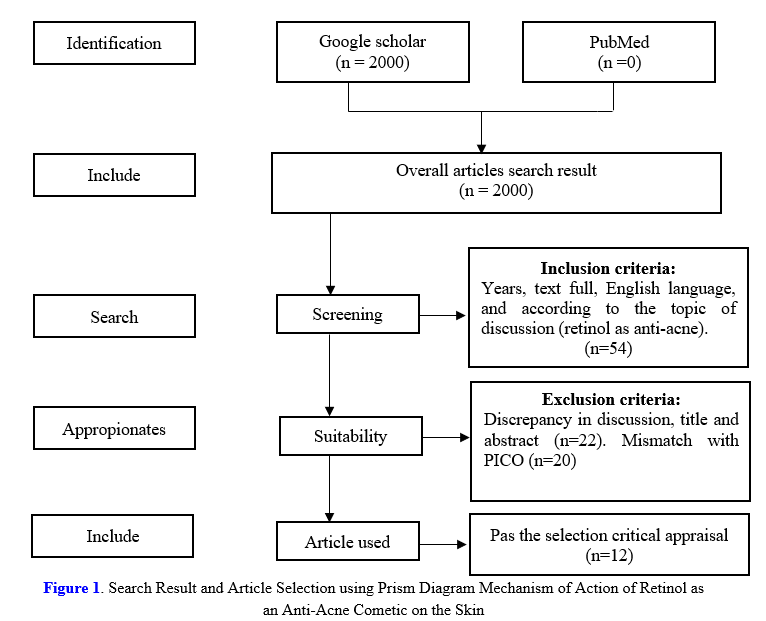Main Article Content
Abstract
Acne is one of the dermatological diseases that often appears in adolescence to adulthood. Retinol (retinyl palmitate) is a first-generation vitamin A derivative used for acne therapy by reducing sebum production which can cause acne bacteria to grow. This study aims to determine the effectiveness and safety of oral and topical retinol preparations. The method used in the study is systematic review using the PubMed search engine and google scholar according to keywords using the PICO method. Articles that can be downloaded with a period of 2013-2023 for the next article are downloaded in selection according to the criteria, namely inclusion and exclusion. The results of the selection of inclusion criteria there are 12 journals to discuss the effectiveness and safety related to topical preparations and peroral retinol as anti-products acne. The mechanism of action of topical retinol is to reduce the production of micro-comedones caused by the bacteria Propionibacterium acnes (P. acne) for oral retinol has the mechanism of action works by inhibiting the production of sebum by androgen hormones in the 3-alpha-hydroxysteroid oxidation pathway using the enzyme retinol dehydrogenase to retinaldehyde to be able to dissolve and be delivered at the destination. Oral or topical retinol preparations provide different side effects. Topical retinol has a lower rate of side effects compared to oral retinol. The level of safety and effectiveness of topical retinol preparations is better than oral retinol.
Keywords
Article Details

This work is licensed under a Creative Commons Attribution-NonCommercial 4.0 International License.
References
- Arjan Aryal &; Sbaita Upreti. 2017. A Brie Review on Systematic Retinoids. International Journal Pharmaceutical Sciences and Research (IJPSR), 8(9), 3630-3637.
- Bernauer U, Laurent B, Leonardo C, Qasim C, Pieter jan Coenraads, Maria Dusinka, Jeanne Duus-Johansen, Janine Ezendam, Eric Gaffet, Corrado Lodovico Galli et al,2016. Scientific Committee on Consumer Safety SCCS Opinion On Vitamin A (Retinol, Retinyl Acetate, Retinyl Pelmitate). European Commission. Health and Food Safety (pp. 13-68). European Commission
- Culp L, Moradi Tuchayi S, Alinia H, Feldman SR. 2015. Torelability Of Topical Retinoids: Are There Clinically Meaningful Differences Among topical retinoids? . J Cutan Med Sur, 19, 530-8.
- Dreno B, Shourick J, Kerob D, Bouloc A, Taieb C. 2020. The role of the exposome in acne: results from an international patient survey. J Eur Acad Dermatol Venereol, 34, 1057-1064.
- El-Samahy May, Manal Ahmed Sharara, and Sally Sobhy Abd Elaziz. 2017. Effect Of Topcal application Of Nano Retinol On Mild to Moderate Acne Vulgaris. The Egyptian Journal Of Hospital Medicine, 68(2), 1049-1058.
- Garg Tarun. 2014. Current Nanotechnological Approaches for an Effective Delivery of Bio-Active Drug Molecules in The Treatment of Acne. Artificial Cells, Nanomedicine, and Biotechnology, 44(1), 99-105.
- Gollnick HPM. 2015. From new findings in acne pathogenesis to new approaches in treatment. J Eur Acad Dermatol Venereol, 29(5), 1-7.
- Kubba R, Thappa D. M, Bajaj A. K, &; Rajeev S. 2009. Oral Retinol. Indian Journal Of Dermatol Venerol Leprol (75), 39-40.
- Latter G, Jeffrey E. Gerice, Yousuf Mohammed, Michael S. Roberts, and Heather A. E. Benson. 2019. Review: Targeted Topical Delivery of Retinoids in the Management of Acne Vulgaris: Current Formulations and Novel Delivery Systems. Journal of Pharmaceutics MDPI, 4-26.
- Lawrenson. A 2019. Sundayriley: Retinol Rewind: What The Type Of retinol is Best For yor Skin.http://edit.sundayriley.com/retinol-rewind-what-type-of-retinol-is-best-for-your-skin/ [Accessed 09th March 2022].
- Leung A. K. C &; Barankin B. 2015. Boxcar Acnes Scars. Consultant Pediatr (14), 474-464.
- Marbawi Muhammad I. &; Salim Tamara A. 2019. Maintaining the Authenticity of Electronic Archives in the Digital Age Based on a Systematic Literature Review. Department of Library and Information Science. Faculty of Humanities. University of Indonesia. Depok. Jakarta.
- Michelle W. Lee. 2020. The Detrimental Side Effects Of Retinol: Beyond Beauty Products. Pages 2-10. Portland State university, Pdxscholar. doi: 10.15760/honors.916.
- Nadal M.J, Camargo, GDA, Novatski. A, Macenhan, W.R, Dias D.T, Barboza F.M, Lyra A, Roik J.R, De Paula J.P Somer, et al. 2019. Poli(ɛ-caprolactone) Micropratikels: Physicochemical Characterization and In Vitro Penetration by Photoacoustic Spectroscopy. Journal. Plos.org, 14(3).
- Nast A, Dreno B, Bettoli V, et al 2016. European Evidence-Based(S3) Guidline For The Treartment Of Acne-Update 2016-Short Version. J Eur Acad Dermatol Venereol, 30(8), 1261-1268.
- Ningtiyas Farida Wahyu. 2020. Panduan Literature Review Untuk Skripsi. Fakultas Kesehatan Masyarakat. Universitas Jember.
- Nursalam. 2020. Penulisan Literature Review dan Systematic Review Pada Pendidik Kesehatan. Fakultas Keperawatan. Universitas Airlangga.
- Radtke M, Alexa P, Fanny K, Jürgen L, Roland R. Nezt. 2017. Ratchet Effect for Nanoparticle Tansport in Hair Follicles. Journal European Journal of Pharmaceutics and Biopahrmaceutics, 16, 125-130.
- Rocha M.A, Bagatin E. 2018. Adult-Onset acne: prevalence, impact, and managemet challenges. Clin Cosmet Investig Dermatol, 11, 59-69.
- Sharara M. A, May E and Abd Elaziz S. 2017. Effect Of Topcal application Of Nano Retinol On Mild to Moderate Acne Vulgaris. The Egyptian Journal Of Hospital Medicine, 68(2), 1049-1058.
- Zasada M and Budzisz E. 2019. Retinoids: Active molecules influencing skin structure formation in cosmetic and dermatological treatments. NCBI Journal of Advances in dermatology and Allergology, XXXVI
